Peter D. Dueben
DiffDA: a diffusion model for weather-scale data assimilation
Jan 11, 2024Abstract:The generation of initial conditions via accurate data assimilation is crucial for reliable weather forecasting and climate modeling. We propose the DiffDA as a machine learning based data assimilation method capable of assimilating atmospheric variables using predicted states and sparse observations. We adapt the pretrained GraphCast weather forecast model as a denoising diffusion model. Our method applies two-phase conditioning: on the predicted state during both training and inference, and on sparse observations during inference only. As a byproduct, this strategy also enables the post-processing of predictions into the future, for which no observations are available.Through experiments based on a reanalysis dataset, we have verified that our method can produce assimilated global atmospheric data consistent with observations at 0.25degree resolution. The experiments also show that the initial conditions that are generated via our approach can be used for forecast models with a loss of lead time of at most 24 hours when compared to initial conditions of state-of-the-art data assimilation suites. This enables to apply the method to real world applications such as the creation of reanalysis datasets with autoregressive data assimilation.
A Generative Deep Learning Approach to Stochastic Downscaling of Precipitation Forecasts
Apr 05, 2022



Abstract:Despite continuous improvements, precipitation forecasts are still not as accurate and reliable as those of other meteorological variables. A major contributing factor to this is that several key processes affecting precipitation distribution and intensity occur below the resolved scale of global weather models. Generative adversarial networks (GANs) have been demonstrated by the computer vision community to be successful at super-resolution problems, i.e., learning to add fine-scale structure to coarse images. Leinonen et al. (2020) previously applied a GAN to produce ensembles of reconstructed high-resolution atmospheric fields, given coarsened input data. In this paper, we demonstrate this approach can be extended to the more challenging problem of increasing the accuracy and resolution of comparatively low-resolution input from a weather forecasting model, using high-resolution radar measurements as a "ground truth". The neural network must learn to add resolution and structure whilst accounting for non-negligible forecast error. We show that GANs and VAE-GANs can match the statistical properties of state-of-the-art pointwise post-processing methods whilst creating high-resolution, spatially coherent precipitation maps. Our model compares favourably to the best existing downscaling methods in both pixel-wise and pooled CRPS scores, power spectrum information and rank histograms (used to assess calibration). We test our models and show that they perform in a range of scenarios, including heavy rainfall.
Bridging observation, theory and numerical simulation of the ocean using Machine Learning
Apr 26, 2021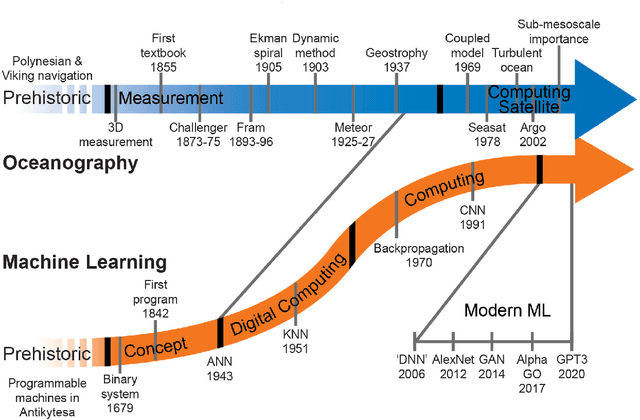

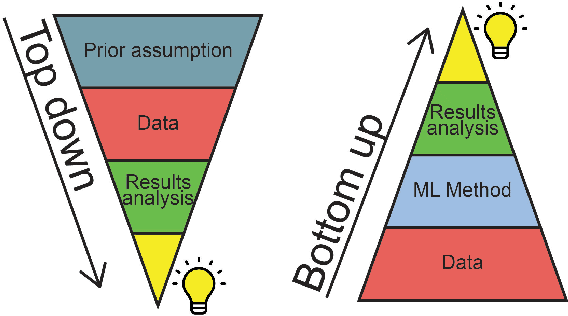
Abstract:Progress within physical oceanography has been concurrent with the increasing sophistication of tools available for its study. The incorporation of machine learning (ML) techniques offers exciting possibilities for advancing the capacity and speed of established methods and also for making substantial and serendipitous discoveries. Beyond vast amounts of complex data ubiquitous in many modern scientific fields, the study of the ocean poses a combination of unique challenges that ML can help address. The observational data available is largely spatially sparse, limited to the surface, and with few time series spanning more than a handful of decades. Important timescales span seconds to millennia, with strong scale interactions and numerical modelling efforts complicated by details such as coastlines. This review covers the current scientific insight offered by applying ML and points to where there is imminent potential. We cover the main three branches of the field: observations, theory, and numerical modelling. Highlighting both challenges and opportunities, we discuss both the historical context and salient ML tools. We focus on the use of ML in situ sampling and satellite observations, and the extent to which ML applications can advance theoretical oceanographic exploration, as well as aid numerical simulations. Applications that are also covered include model error and bias correction and current and potential use within data assimilation. While not without risk, there is great interest in the potential benefits of oceanographic ML applications; this review caters to this interest within the research community.
Machine Learning Emulation of 3D Cloud Radiative Effects
Mar 22, 2021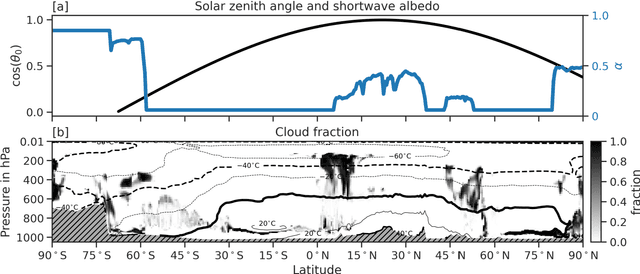
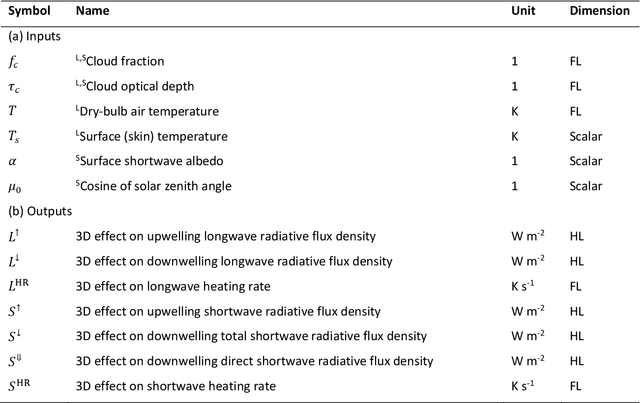

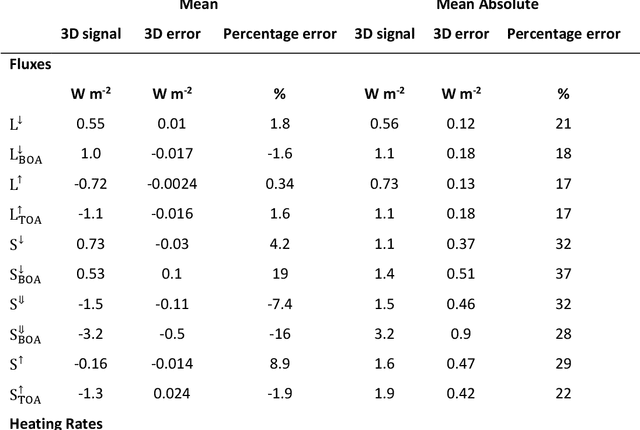
Abstract:The treatment of cloud structure in radiation schemes used in operational numerical weather prediction and climate models is often greatly simplified to make them computationally affordable. Here, we propose to correct the radiation scheme ecRad -- as used for operational predictions at the European Centre for Medium-Range Weather Forecasts -- for 3D cloud effects using computationally cheap neural networks. 3D cloud effects are learned as the difference between ecRad's fast Tripleclouds solver that neglects them, and its SPeedy Algorithm for Radiative TrAnsfer through CloUd Sides (SPARTACUS) solver that includes them but increases the cost of the entire radiation scheme by around five times so is too expensive for operational use. We find that the emulator can be used to increase the accuracy of both longwave and shortwave fluxes of Tripleclouds, with a bulk mean absolute error on the order of 20 and 30 % the 3D signal, for less than 1 % increase in computational cost. By using the neural network to correct the cloud-related errors in a fast radiation scheme, rather than trying to emulate the entire radiation scheme, we take advantage of the fast scheme's accurate performance in cloud-free parts of the atmosphere, particularly in the stratosphere and mesosphere.
WeatherBench: A benchmark dataset for data-driven weather forecasting
Feb 12, 2020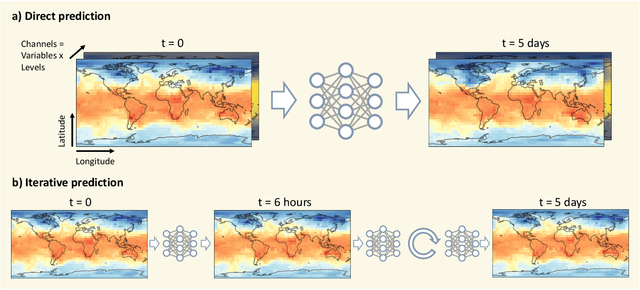
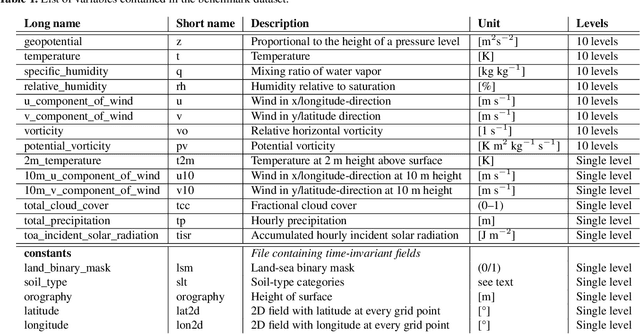
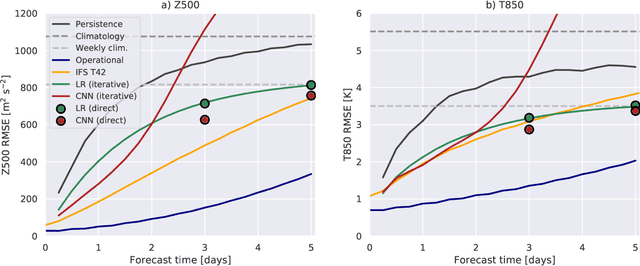

Abstract:Data-driven approaches, most prominently deep learning, have become powerful tools for prediction in many domains. A natural question to ask is whether data-driven methods could also be used for numerical weather prediction. First studies show promise but the lack of a common dataset and evaluation metrics make inter-comparison between studies difficult. Here we present a benchmark dataset for data-driven medium-range weather forecasting, a topic of high scientific interest for atmospheric and computer scientists alike. We provide data derived from the ERA5 archive that has been processed to facilitate the use in machine learning models. We propose a simple and clear evaluation metric which will enable a direct comparison between different methods. Further, we provide baseline scores from simple linear regression techniques, deep learning models as well as purely physical forecasting models. All data is publicly available at https://mediatum.ub.tum.de/1524895 and the companion code is reproducible with tutorials for getting started. We hope that this dataset will accelerate research in data-driven weather forecasting.
 Add to Chrome
Add to Chrome Add to Firefox
Add to Firefox Add to Edge
Add to Edge